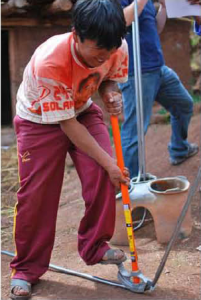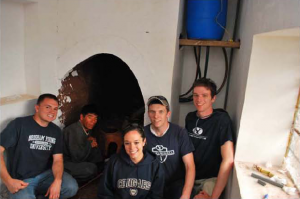Brandon Decker and Dr. Matt Jones, Department of Mechanical Engineering
This group aimed to construct a system that heated water to at least 38°C (100 OF) – warm enough for bathing, dish washing, and washing hands. Our goal was to create a system inexpensive and simple enough for implementation in Huatta, Peru. We also aimed to make the system sustainable and replicable.
In the United States, we take warm water for granted. When we clean and bathe, we simply turn the hot water faucet and wait a few seconds for warm water to start flowing. In Huatta, Peru, a village of about 100 families, the only method for heating water for bathing is tedious: setting a pot of water over a fire until it is warm. This method heats small amounts of water and is a time consuming task. In addition, wood fuel is a relatively scarce resource, and villagers can only afford to build fires for cooking. Therefore, bathing and cleaning are usually neglected due to the coldness of the mountain waters. A system that warms a 20-gallon tank of water from waste heat during cooking times would provide a volume of easily accessible warm water for an entire family. Implementing these systems throughout the village would result in better sanitation and health.
Our group took on the challenge of designing a water heating system for the people of Huatta, Peru. Our design focused on using waste heat from a cooking fire to heat a tank full of water for bathing. One key design element was the steel heat transfer pipes in the cooking stove. When designing our first prototype, we tried to optimize the heat transfer by maximizing the surface area of piping inside the stove. However, we quickly realized that the pipe geometry was too complex to be replicable. After several months, we eventually settled on a simpler design that could be built with inexpensive tools.
Although engineering and design constraints were a major factor in our project, one of our biggest concerns was meeting the social requirements of the villagers. Past projects like ours have failed due to unresolved social concerns. During the implementation trip, we found that it was critical to be cognizant of social needs and other unforeseen factors as they arose. For example, we had almost finished constructing one water heater when a villager became concerned that the presence of a large pot on the stove would divert flames toward the plastic tubing of the water line. Luckily, we were able to find a work-around by shielding the tubing. Better communication with the villagers throughout the design and implementation processes may have prevented this setback.
The trip was a big success and we were happy to install one complete water heating system while also leaving some essential supplies so they could quickly make another. The villagers were anxious to learn the engineering behind our design; we made sure to dedicate some time to distribute instruction manuals and to explain all the principles behind the system to the villagers who were involved in our project.
The villagers possessed or were taught the skills to use all the tools needed to construct a water heating system. With entirely new parts, the system costs about 120 PEN (about $40); however, the villagers have a lot of the materials already available in their village. The villagers were confident that they could build more water heaters, and we believe that our design is truly sustainable.
This was a great experience for us on multiple levels. As engineers, we were able to work through the entire design and implementation process of an idea we had. Of course, we were also thrilled to experience a new culture and spend time getting to know people so far away. On top of that, we also had the joy of providing humanitarian service to some small villages. It has definitely been a landmark experience in all of our lives.


